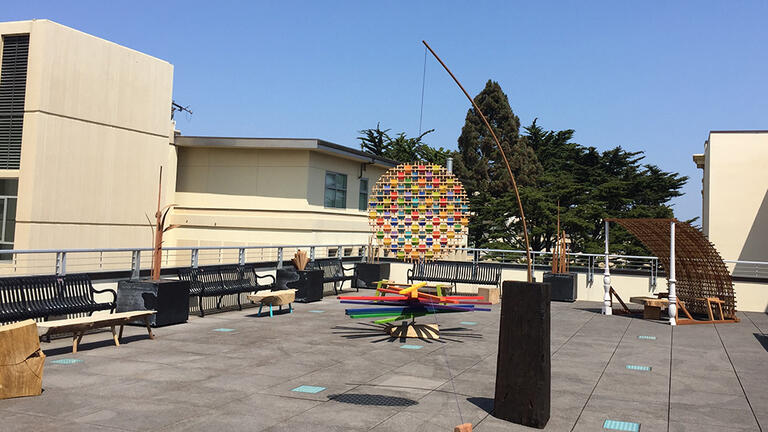
2018
POROUS: New Works by Jonathan Anzalone

August 20 – December 16, 2018
On the Kalmanovitz Hall Sculpture Terrace
For the past ten years, I have maintained a wood shop and art studio in San Francisco. During that time I discovered a shared dialogue between furniture and art making. They both explore a process and require an investigation of technique and materials. This porous interchange provides the foundation for the current installation.
I am attracted to organic and geometric structures that readily reveal their inherent qualities. The natural world–ocean, flora and fauna, and weather–are my primary influences.
Engaging the synergies of furniture and art has the potential to stimulate sight, sound, smell and touch. I hope that the installation will offer the viewer room for interpretation, allow appreciation for simple materials and ultimately grant a sense of well-being."
About the Artist
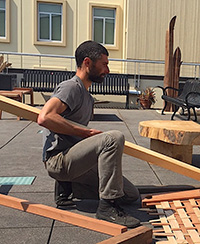
A graduate of the Rhode Island School of Design, Jonathan Anzalone apprenticed for three years with the New England furniture maker Peter Murkett, during which time woodworking became a passion that supported his art making.
After moving to the Bay Area, Jonathan co-founded Anzfer Farms, a studio committed to creating unique objects and installations that erased distinctions between functional and non-functional objects and residential and gallery spaces. He currently works independently, maintaining a workshop exploring the boundaries and intersections between furniture and art.
Quiet Spaces: Picturing Sanctuary in the Illustrated Book
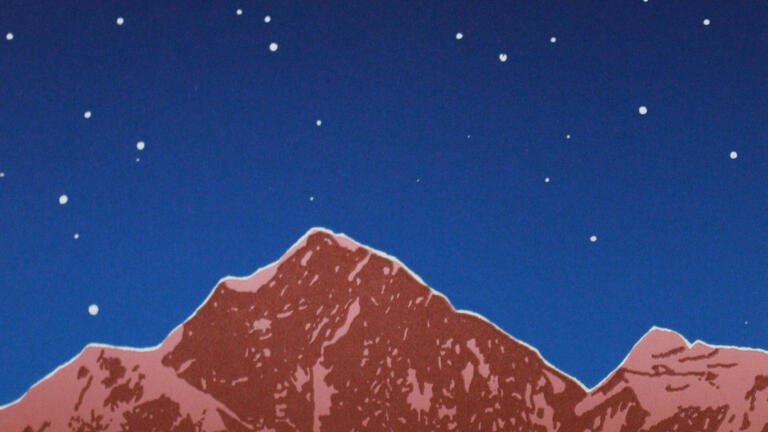
November 29, 2018 - February 10, 2019
Sanctuary, a safe place of refuge, can be found not only in a physical place of shelter, but also in the vastness of nature or the comfort of home. It can be rooted in a memory, the peacefulness of solitude, or feelings of nostalgia. Quiet Spaces: Picturing Sanctuary in the Illustrated Book celebrates the many and varied ways in which the idea of personal and collective refuge is represented in image and text in modern illustrated books. Depictions of expansive landscapes, moments of seclusion, and gatherings of loved ones bring the notion of refuge to life. Through a range of printed illustrations and photographs, Quiet Spaces encourages the exploration of diverse experiences and perceptions of sanctuary through the lens of modern illustrated books.
Quiet Spaces was curated by the graduate Museum Studies Curatorial Practicum class led by Professor Kate Lusheck, and features objects from the permanent collection of USF's Donohue Rare Book Room.
Allan deSouza: Through the Black Country...
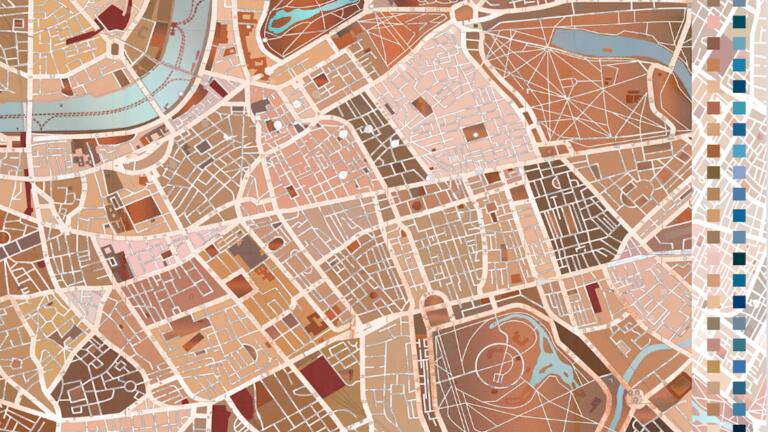
September 4 - November 4, 2018
Allan deSouza’s Through the Black Country, or, The Sources of the Thames Around the Great Shires of Lower England and Down the Severn River to the Atlantic Ocean reenacts and upends iconic colonial narratives of discovery in Africa. The exhibition is based on the expedition diaries of the Zanzibari crypto-ethnologist Hafeed Sidi Mubarak Mumbai, the fictional great-grandson of the historic figure, Sidi Mubarak Bombay—a formerly enslaved African who, upon gaining his freedom in India, returned to Africa and lead numerous British expeditions across the continent. In this installation, comprised of photographs, diary extracts, and sculptural works, Hafeed sets off to fulfill his great grandfather’s unfulfilled wish—to discover the fabled and elusive source of the River Thames.
Organized by Krannert Art Museum, University of Illinois at Urbana-Champaign
Curated by Allyson Purpura with Bay Area artist Allan deSouza
View the exhibition object list
Through the Black Country... Educational Resources
About the Artist
Allan deSouza is internationally acclaimed for his photographic, installation, text, and performance works that restage historical evidence through counter-strategies of fiction, erasure, and (mis)translation. In addition to his art practice, deSouza is chair of the department of Art Practice at the University of California, Berkeley. His current book project, How Art Can Be Thought, an examination of art pedagogy and a lexicon of terms used within the art critique, will be published in 2018.
Eudaimonia: The 19th Thacher Art + Architecture Annual
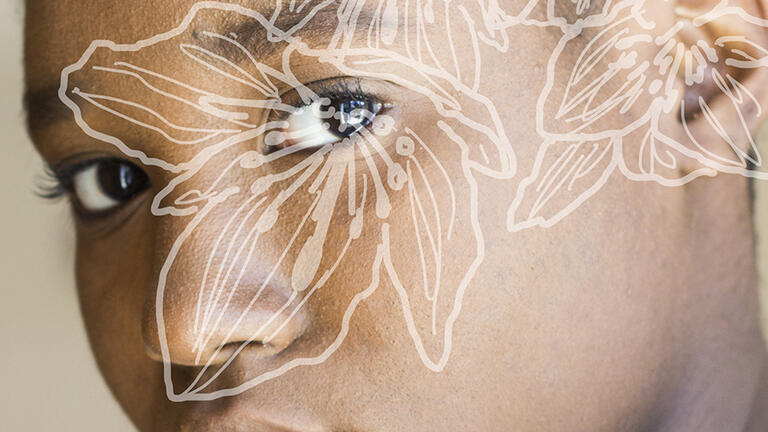
May 4—June 29, 2018
In its 19th year, the Thacher Annual celebrates artwork by 40 junior and senior majors and minors from the University of San Francisco’s Department of Art + Architecture. The exhibition’s student organizers have chosen the title Eudaimonia (eu·dae·mo·nia), a Greek word that roughly translates to “human flourishing.” The exhibition highlights the artists’ personal and creative evolutions during their time at USF.
Just as organic life blooms and flourishes, so do we, ever molding into greater human beings. The artwork in Eudaimonia reflects varying human experiences, allowing viewers an opportunity for self-reflection.
Eudaimonia was organized by the Thacher Gallery Practicum class, providing an opportunity for undergraduate students to learn and apply the process of curating and implementing a professional, juried exhibition. The show’s jury included artists Paz de la Calzada and Marshall Elliott, designer, author, and Design Action Collective co-founder Innosanto Nagara, and Haight Street Art Center executive director Peter McQuaid. The exhibition features 69 artworks of various media, including paintings, audio, digital, print, graphic design, and ceramics.
Opening events will be May 4, with an awards ceremony at 4pm in the Xavier Auditorium in Fromm Hall, followed by a reception in the Thacher Gallery.
Exhibiting Artists
- Yasmeen Abedifard
- Fredo Alvarez
- Allison Arriola
- Megan Badilla
- Justin Barreras
- Esperanza Carmona
- Marisa Centrella
- Bailey Dare Chaconas
- Maya Chin
- Noa Chupkov
- Elora Cuenco
- June Dao
- Genesis DeJesus
- Tin Dinh
- Joanna Douglas
- John Finkenberg
- Valentina Flores
- Alex Foster
- Christine Gonzalez
- Monica Greene
- Terence Ho
- Lauren Imada
- Jackie Isbell
- Gina Kuhlmann
- Danlu Liang
- Ema Matsumura
- Shana Mofarrah
- Casey Moylan
- Tiffany Nassirian
- Joshua Oakley
- McKenna Pahl
- Ginelle Dela Peña
- Giovanni Presutti
- Amber Ramirez
- Laura Schmaeler
- Jackie Todani
- San Trieu
- Saorise-Naomie Weaver
- Rose Yao
- Shijia Zhang
Student Organizers
Subject Matter
- Heather Butler
- Chloe Damiba
- Delaney Gibbons
- Christine Guo
- Giovanni Presutti
Design
- Lily Basting
- Carrie Deng
- Grace Hale
- Zoila Marquez
- Nina Vukic
Visitor Experience
- Victoria Fraire
- Pengxin Guo
- Chaniece Jefferson
- Jordan Sandoval
- Luis Sepulveda
Nell Herbert and Glori Simmons, instructor
Anting Anting | Magic Objects by Michael Arcega
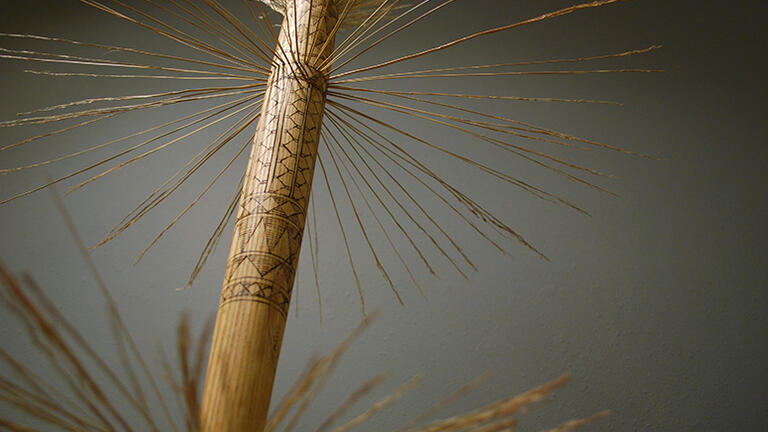
March 5 – April 15, 2018
Anting Anting | Magic Objects presents ceramic, mixed media and found objects that play on mysterious practices from artist Michael Arcega’s Filipino culture and experiences.
These handmade objects explore the indigenous Filipino concept of anting anting, a belief that everyday items and handcrafted amulets etched with symbols can heal, bring prosperity, protect and strengthen through ritual and prayer. After Spanish colonization, anting anting appropriated imagery from Catholicism. It is still practiced by many today.
As a child in the Philippines, Arcega encountered anting antings and the practice of the albularyos and hilots, seers and healers. Arcega draws from these memories to recreate commonplace items that have special meaning in his own life. Serving as functional, decorative and spiritual objects, they guard from the looming threats that surround us and empower those who believe.
Merging fine arts practices with an anthropological sensibility, Arcega invites viewers to consider the power of belief and ordinary objects in our lives.
Presented by Thacher Gallery. Co-sponsored by Asian Pacific American Studies and Yuchengo Philippine Studies Program.
About the Artist
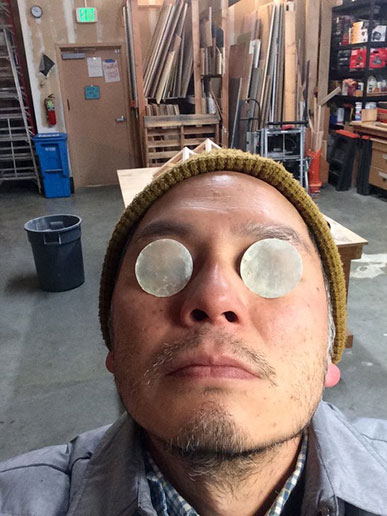
Born in Manila, Philippines, Michael Arcega migrated to Los Angeles at the age of ten. He is an interdisciplinary artist working primarily in sculpture and installation. His work revolves around language and sociopolitical dynamics. Directly informed by historic narratives, material significance, and geography, his subject matter deals with inequitable power relations.
Arcega has a BFA from the San Francisco Art Institute and an MFA from Stanford University. His work has exhibited at the Asian Art Museum, Museum of Contemporary Art in San Diego, the de Young Museum, Yerba Buena Center for the Arts, the Orange County Museum of Art, The Contemporary Museum in Honolulu, the Museum of Fine Arts in Houston, Cue Arts Foundation, and the Asia Society in NY among many others. He currently lives and works in San Francisco, California where he is an Assistant Professor at San Francisco State University.
-
Michael Arcega
March 5-April 15, 2018
Thacher Gallery at USFDOÑA SEÑORITA
(Matriarchal power enhancement)
Ceramics, steel, wax, fabric, crystals and mixed media
2018BEISBOL CLUB: PEN15 CLUB
(Over - compensation wand or fertility club)
Wood,& feathers,& crystal and stand
2015BULA-BULA / BOLA-BOLA
(Implement for creating shallow and fleeting happiness)
Ceramics, pyrography on wood, fur, string and potion
2018IN BE-TWIN
(For harnessing the power of opposites)
Ceramics, silicone, candle, fabric and
potion 2018KULAM: NAVY
(Object for focusing curses)
Straw, miniature clothing and
pins 2018KULAM: SS
(Object for focusing curses)
Straw, miniature clothing and
pins 2018BATONG BATO
(For alieving boredom or items for throwing)
Ceramics and cork (gasoline is optional)
2018KALABASANG / KABOCHA FLASK FOR TAGAY
(Squash container for getting “squashed”)
Ceramics, cork, alcohol and fabric
2018PUT TONGUE IN A MOOD
(Post-lingual crutch)
Ceramics, twine and doily (gasoline is optional)
2018DEKCUF GARMENT
(Anti-power costume for waiting)
Jumpsuit, ink, rhinestones and emergency blanket
2018SWERTE OR IWAS-MALAS
(Power cape or partial furry-rainbow)
Fur, acrylic and burloloy (crystals, coral, sticks,
capiz shells, broken needle and magnet, lucky
pins, whip, plastic, coral, patch, safety pins
and partial baby-blanket)
2018TRUKNUT
(Fertility talisman)
Blue sticky-tack putty, nail and primer paint
2015MYLEFTFOOT
(Symbol of disbelief with Nacireman stories)
Cast of foot, sheep fur and
books 2015BEISBOL CLUB: FAHYERBATTE
(Incendiary Device)
Wood, phosphorous and grip
tape 2015BEISBOL CLUB: HEILOMAKER
(Unknown purpose)
Wood and phosphorous
2015BEISBOL CLUB: HEADHUNTER’S BROOM
(Ceremonial cleansing)
Pyrography on wood and
hay 2015XYLOPHONEME
(Kulintang Buto)
Aksarben cow bones, ink, oak, fox pelt, osprey
feather, coral, sisal and Nacireman artifacts
2015UNI-VERSALINITY
(The original asin [salt])
Sea Urchin, Capiz shell and fancy crystal
20188008
(Comfort object)
Silicon
201
Portale by Paz de la Calzada
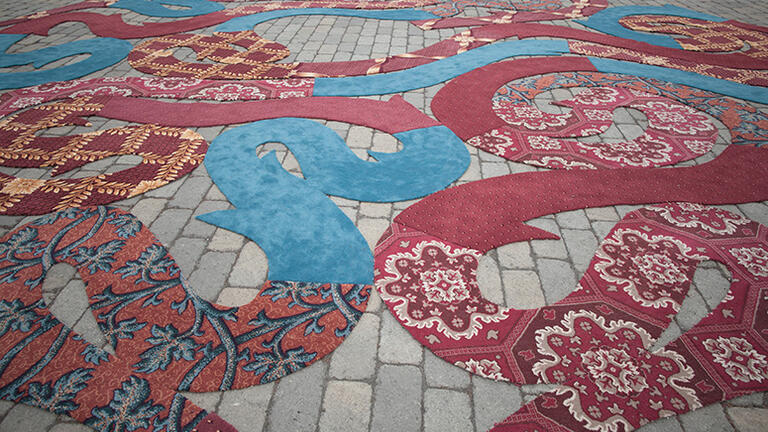
Kalmanovitz Hall Sculpture Terrace
Portale by Paz de la Calzada
Feb. 5 – Mar. 25, 2018
In Portale, artist Paz de la Calzada explores ideas of passage and transformation through a site-specific installation that creates a path through the stone portal in Kalmanovitz Hall’s Giraulo Atrium to the Nomadic Labyrinth on the building’s rooftop sculpture terrace.
Dated 1175-1200, the Romanesque portal featuring Adam and Eve and the Tree of Knowledge was originally from the Chapel of the Penitents in Northern Italy. Taken from its original sacred space and later donated by the de Young Museum to be placed in the heart of an academic building dedicated to the arts and humanities, it is now a reminder of many passages: from one place to another, from the past to the present, from the tangible world to the spiritual realm.
For Portale, de la Calzada incorporates a common ornamental pattern used in churches of Northern Italy to form a path that links the monument and the space, while inviting visitors to begin a new journey through the portal to the Nomadic Labyrinth. Used throughout history and in spiritual practices around the world, labyrinths serve as paths for contemplation, meditation, and reflection. Using gaudy reclaimed carpets from hotels and casinos, de la Calzada evokes with irony the relationship between the sacred and the profane.
Presented by Thacher Gallery. Co-sponsored by Theology and Religious Studies, The Joan and Ralph Lane Center for Catholic Social Thought and the Ignatian Tradition, and University Ministry.
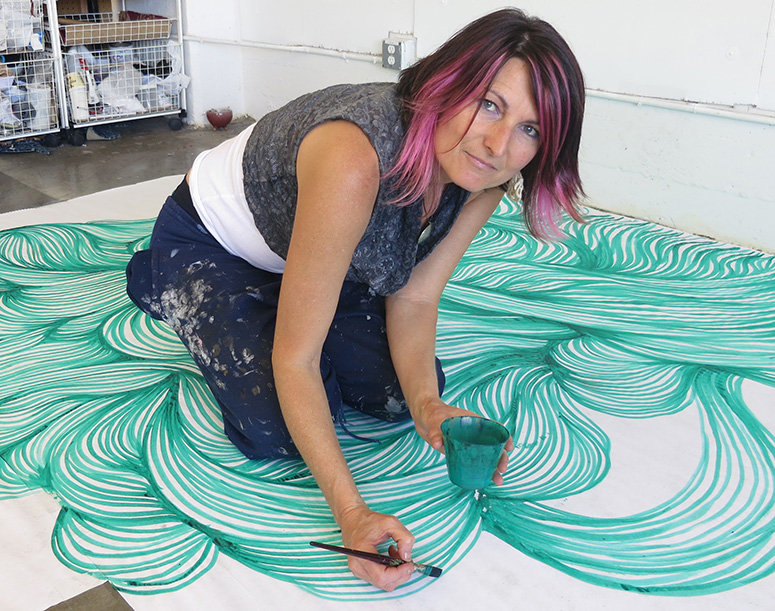
About the Artist
Paz de la Calzada, a native of Spain, is a San Francisco based artist working in site-specific drawing and temporary projects that have a real and direct interaction with the public. Her whimsical installations play with existing architecture, responding to social, historical or spatial context.
Using everyday materials to interweave the public and private space, she explores the relationship between urban environment, daily life and ritual. Paz presents her work as a playful examination of the world, the human psyche and the interconnectedness of human beings.
De la Calzada’s work has been shown nationally and internationally, including the San Jose Museum of Art, the Palo Alto Art Center, the de Young Museum, YBCA, the Union Fenosa Museum and the Fundacion Caixa Galicia in Spain, the Leon Trotsky Museum and the San Angel Cultural Center in Mexico City.
De la Calzada came to the San Francisco Bay Area in 2003 as an Artist in Residence at Djerassi Resident Artist Program. Since then she has been in several residency programs like Kala Art Institute in Berkeley, Millay Colony for the Arts in New York, ArtAmari in Crete and most recently Tvak Studios in India. Her interactive public art project, The Nomadic Labyrinth, is a recipient of the Cultural Equity Grants by the San Francisco Arts Commission.